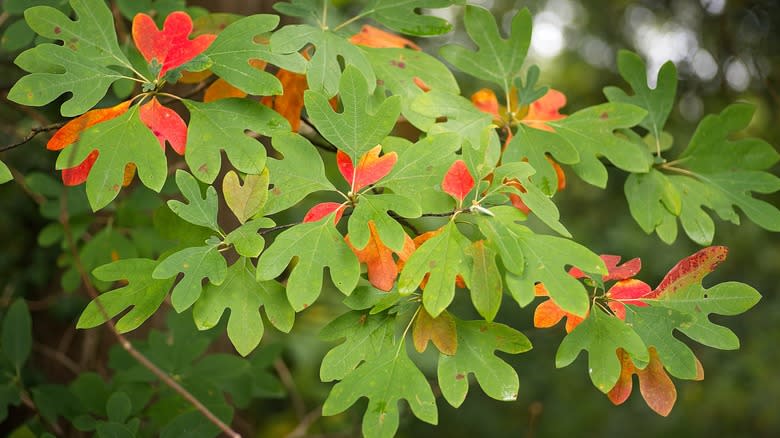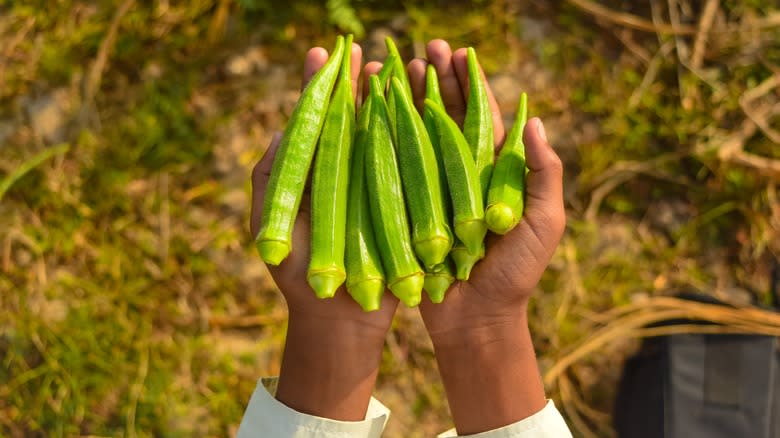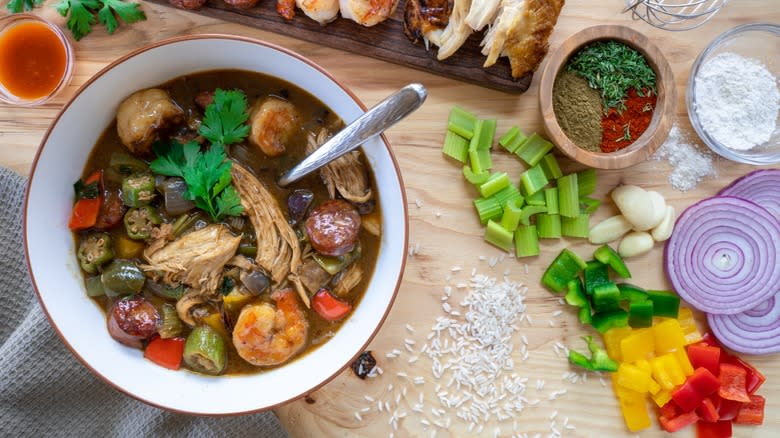Why Filé Powder Was Once Considered A Serious Carcinogen

We may receive a commission on purchases made from links.
There are as many iterations of gumbo as there are ingredients to throw in the pot: onion, sausage, chicken, leftover Thanksgiving turkey, and Creole seafood gumbo -- whatever's convenient to the hand and appealing to the eye. But to make proper filé gumbo, you must include at least two things: okra and filé powder, or ground dried sassafras leaves. The former is widely available and uncontroversial; the latter virtually disappeared from the dish (despite its use predating colonial settlement) because it was mistakenly considered a carcinogen.
To be clear, filé powder is not carcinogenic. But it does come from sassafras albidum, an aromatic deciduous tree whose root bark and fruit contain a substance called safrole, which the National Library of Medicine describes as "reasonably anticipated to be a human carcinogen". (Small quantities of safrole are found in seasonings like nutmeg and pepper.) Sassafras oil, historically used for cooking and medicine, contains quite a bit of safrole (about 80%) and was consequently banned as a food additive by the FDA in 1960. Safrole is still controversial: It's considered a List I substance by the DEA because of its use in the manufacture of MDMA (or ecstasy). However, tests conducted in the 1990s on sassafras leaves -- from which filé powder is made -- found virtually undetectable levels of safrole, according to the National Library of Medicine.
Read more: The Best Grocery Store In Every State
Thickening Agents Used In Gumbo

Filé powder is one of the three ingredients used as a thickening agent in gumbo. Okra is another, and the third is roux, a paste consisting of flour browned in fat. Creole or Cajun roux is a considerably darker, more robust cousin to its more delicate French ancestor, which originated in the 17th century. Roux is made at the beginning of the dish, either with butter (like the French), bacon fat, or ... whatever -- 18th century Creole cooks in Louisiana were known to use bear fat to make their roux. Okra goes in the pot and might be the first gumbo ingredient ("ki ngombo" is the West African word for okra; enslaved people brought the plant's seeds with them to the New World.) Okra thickens the stew because it contains a viscous substance called mucilage, which gets gooier when heated.
Filé powder is incorporated into the gumbo off heat. It also contains mucilage, and if it's subjected to too much boiling will become stringy and unappetizing -- in fact, "filé" is the French word for "stringy." It's believed that filé powder was originally used in the winter months when okra wasn't available -- although some cooks dried their okra for just this purpose. This seasonal variation is the likely reason different gumbo recipes fell under one of two umbrella categories: Those made with okra, like Green Gumbo (dishes known as "gumbo févi"), and gumbo filé.
History In Your Bowl Of Gumbo

French and Spanish colonists noticed that the indigenous Choctaw people were making vigorous use of the sassafras tree, grinding the leaves to thicken stews made of poke leaves, corn, and local seafood or boiling the root bark to lessen fevers, cleanse wounds, and ease stomach pain. Quickly exported to Europe (becoming an early cash crop), the tree and its derivatives were soon used to make perfumes, soap, and medicine. Oh, and sassafras literally put the "root" in root beer.
Even if you've never used filé powder, you can probably identify the smell of it: It has a fruity, eucalyptus-adjacent fragrance and taste that sits perfectly on top of the dark, earthy gumbo flavors of a browned roux and smoked Andouille sausage. Buy a jar and use it as a condiment for your next foray into the world of Creole and Cajun gumbo, placed on the table next to your favorite bottle of hot sauce.
Read the original article on Daily Meal.

